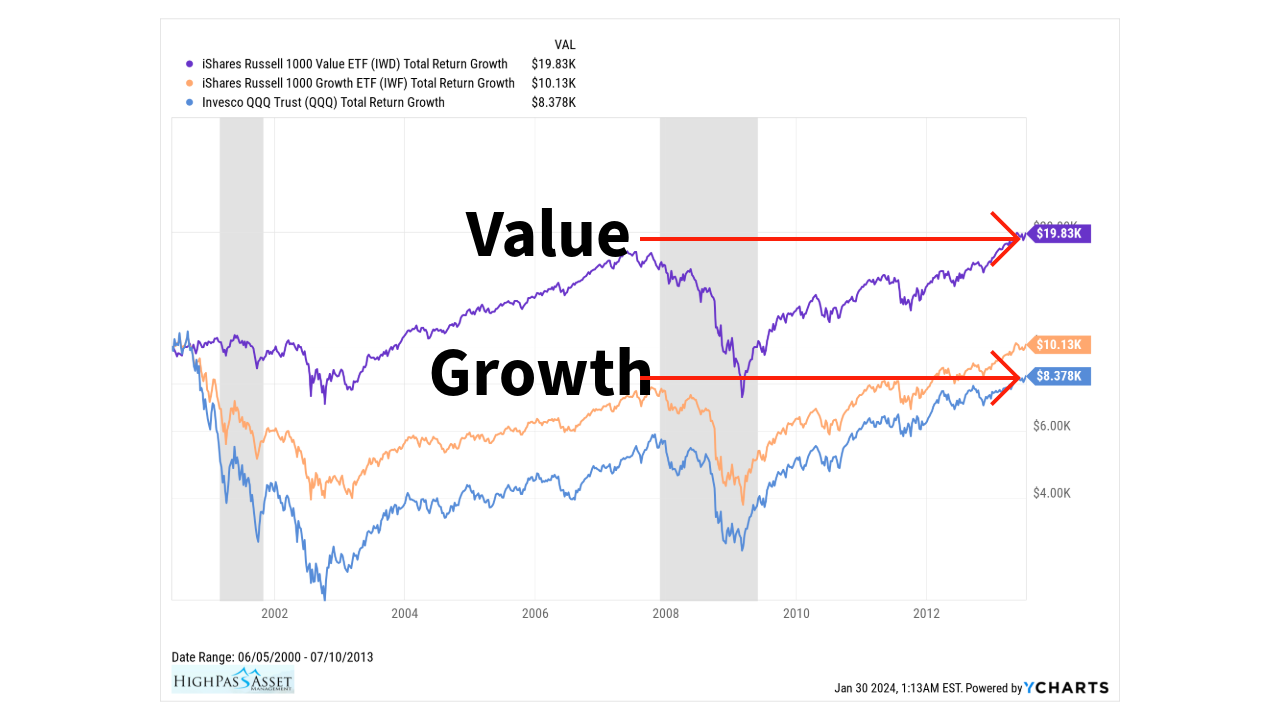Recessions and bear markets are a normal part of the business cycle. There have been ten recessions in the past seventy years; with a recession occurring about every seven years on average.
Bear markets come in two varieties, short term, and secular. Short term bear markets may last only one or two years while secular bear markets can last more than a decade.
The focus of this article is to help prepare you to invest in secular bear market that may be accompanied by one or several recessions.
Since 2009 we have been in a secular bull market. At fifteen years old, the current bull market may not have much time left to run. Preparing your portfolio for the inevitable bear market can save your retirement.
Before we dive into what area of the stock market to focus on during a secular bear market, let us first review what a secular bear market looks like. In the chart below, you can see that the stock market has an extremely easy to identify staircase pattern. Secular bull markets eventually turn into secular bear markets back and forth, back, and forth. The S&P 500 has experienced two secular bear markets since inception. During a secular bear market, you may not have any return from price appreciation for more than a decade.
Learn the Long Term Market Pattern

This is a Secular Bear Market

From 2000 – 2013 the S&P 500 had no return on price and two serious drops. There were two recessions during that period. You can see the recessions shaded in gray.

The period from 1968 – 1982 was like 2000 – 2013. From 1968 – 1982 the S&P 500 had no return on price and a lot of volatility.
Now that we know what a secular bear market is and what a secular bear market looks like, how do we invest in a secular bear market? In the last two secular bear market periods, dividends continued to grow while stocks went sideways. In the next secular bear market, dividend paying stocks and stock indexes should be at the top of your list.
Companies or indexes thattrade at multiples of earnings (PE), book value that are less that then S&P 500 and pay a dividend yield greater than the S&P 500 should be a focal point. Often stocks or indexes with this description are called “value stocks” or “blue chips.”
Value Beats Growth in a Secular Bear Market

In the chart above, we are comparing three popular ETFs to see how they performed during the 2000 – 2013 secular bear market. These three ETFs demonstrate two distinctive styles of investment: value and growth. In this analysis, we are making a $10,000 investment in each of the three ETFs in the summer of 2000 (the earliest common start date for all three of these ETFs) and reinvesting the dividends.
The purple line is the Russell 1000 Value ETF. The orange line is the Russell 1000 Growth ETF, and the blue line is the Nasdaq 100. Over the course of the secular bear market, you can see that even with dividends reinvested, the Nasdaq 100 was losing money after thirteen years and the Russell 1000 Growth ETF was flat.
Value stocks, however, made you money during this secular bear market. The higher dividends and lower PE of the Russell 1000 Value ETF were much more attractive to investors during the 2000 – 2013 secular bear market. As a result, investors received a return from both price appreciation and dividends.
When the next bear market is upon us, I do not believe that we will see any change from the historical precedent for what works during a bear market. If your portfolio is heavy on growth, now is the time to review your investment strategy. During a secular bear market, growth stocks are likely to suffer while value stocks become more interesting. Focus on dividends and price so that you can keep your wealth working for you.
Ethan S. Braid, CFA
President
HighPass Asset Management
Denver, CO
Your broker or advisor will charge you fees or commissions to make investments and therefore your returns will be less than indexes. For example, if you invest in the S&P 500 ETF, SPY, you will pay a fee to the company managing the ETF, State Street Global Advisors. Your return on the S&P 500 ETF, SPY, will be less than the S&P 500 Index TR because of the fee paid to State Street Global Advisors. Additionally, you may pay a fee or commission to your broker or financial advisor, further reducing your return, below the index. Consult your advisor or broker for a detailed list of their fees or commissions before you invest. Investing involves risk and you can lose money.

